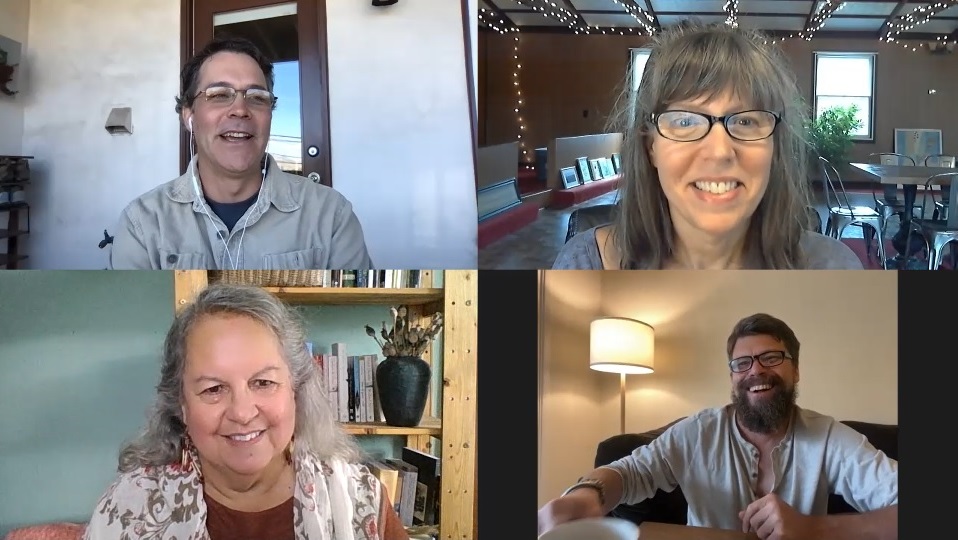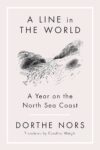It’s not news to write that divisive and exploitative relations — human to human, human to creature, human to planet — are dominating the headlines and bringing earth to a tipping point. What would it look like to preference narratives of mutuality and reciprocity? Gavin Van Horn, Robin Wall Kimmerer, and John Hausdoerffer have answered that question in co-editing the five volume series Kinship: Belonging in a World of Relations (Center for Humans and Nature Press, 2021). Featuring essays, poems, interviews, and stories from around the globe, Kinship becomes for the reader an immersive experience in a complex, intelligent, and virtuosic web of connectedness.
I spoke with Gavin, Robin, and John via video. This conversation has been edited for clarity and flow. The second half of our conversation will be published on Thursday.

Cara Benson: Something that seems to be an underlying belief in many Western conservation or environmental movements is the idea of the human as destroyer. Certainly there’s good reason to think that, but that leads to a conservation based on separation. The goal becomes to hold aside land without any human involvement with it after that. This obviously erases millennia of Indigenous relationships with land, but it’s also a really unproductive idea for how to move forward. In contrast, I think of Matt Hall’s “Kinship with Plants” [an essay in Volume 5]. The idea of a restorative relationship comes forward in so many of these essays, and I’m wondering if you all could speak to that.
Robin Wall Kimmerer: Yeah, I’d be happy to jump in on that — one of my favorite subjects. To me, one of the important elements of how we get to kinship, or as Gavin likes to say how we kin with one another, is engagement with reciprocity. Kinship arises out of relationship. A give and take between people and landscapes. This Western notion of velvet rope conservation that keeps people out, as you say both denies a long history of participatory reverence by Indigenous peoples in land stewardship, but also that absence is not good for land and it’s not good for us. How do we become kin if we’re not interacting and really getting to know one another?
It reminds me of when I was teaching a general ecology class and I asked my students, who are all part of an environmental college, what was their literacy level around negative interactions between people and land? 300 hands went up, like “oh yeah that’s why we’re here.” Then I turned it around and said, “Tell me about your knowledge of beneficial relationships between people and place.” There were hardly any hands at all. That felt like a body blow. How is it that we’re going to heal from the place where we are when we can’t even imagine beneficial relationships between people and place? In the Kinship books I think that idea of mutual participation threads throughout them. Everyone is talking about the need to participate; the need to both be gifted by the landscape and give back to the landscape, and that’s how we come to belong to a place.
Gavin Van Horn: That story left a deep impression on me when you first told it to me, Robin. And it really clarified the work I do not only at the Center for Humans and Nature, but also for what John and I were trying to do with the Wildness book preceding Kinship. We were highlighting stories of reciprocity because we knew that the stories were out there; they just weren’t being told maybe as loudly or as persistently as the other stories that we hear on a daily basis about humans being a scourge on the planet.
Certainly we have to acknowledge, to grieve, and try to productively work with all those emotions that are the product of the destruction that we see. Most of it is needless destruction, most of it unnecessary. But we wanted to lift up those stories that were about participatory reverence — that great phrase you just used.
I like the idea that humans aren’t born complete. We aren’t born fully human, in other words. We have to become and to live into that humanity, and that is not an isolated process. That is done alongside many, many other-than-human species. What these stories in the Kinship book series are about is how we come into that belonging with those other species and with those landscapes and the worlds that we’re a part of.
John Hausdoerffer: I think what I’ll do is I’ll deconstruct and then reconstruct a little bit. Think of the phrase, conservation of natural resources, and break those three words down. Conservation, if we historicize it, it goes back to the German foresters who were basically treating forests like a crop during a time in which agriculture was being treated like a factory system. That mechanistic view of forests was transported to the American forestry system. Gifford Pinchot, the US Forest Service, the whole regime of the 20th century around conservation was very utilitarian. And it was for use, but not in the kinship kind of form that Robin and Gavin are talking about. It was about extraction so you don’t run out to build an infinitely growing economic machine. Conservation is really problematic in that way.
Natural. Already you’re separating humans from the greater-than-human world with a term like “nature”. And then resources. You’re seeing the world as a stock room when seen from the “resource” perspective, which immediately objectifies the living planet and all the communities that make up our place, our home, of which we are a part.
How do we reconstruct? What’s on the other side of conservation of natural resources is kinship.
For me, it can’t just be this leap frog from here I am as a human being, wanting to connect with the greater-than-human world. I think there has to be kinship between humans on a piece of land that feeds us, in all ways. Spiritually. In terms of our livelihood. In terms of family. If people are connecting through kinship with each other, that leads to kinship with the land. In the story I wrote for the series, I’m trying to figure out where to spread my brother-in-law’s ashes. He had helped me on this piece of land to enrich the health of a suffering aspen grove. By having my brother there with me, my kin, I learned how to kin with that aspen grove. I’m skiing in the winter trying to figure out where to spread these ashes and I finally say,
I know what to do. With frigid hands, I slowly pull the urn out of my pocket. It’s clear, the urn, and the color of the ashes surprise me. Maybe it’s the snow blindness after solstice colors, but there’s a bluish-purple tint to the gray, white-flecked ashes. I cork open the vile and raise the glass like many of the drinks Abe and I raised to this mountain after a good ski. I offer gratitude and say goodbye, wishing Abe a peaceful and well-earned rest, the same words I said to him on his final night as he slowly passed out of consciousness. I smile with ease at the notion of Abe’s ashes feeding this group of trees that I will forever call Abe’s Grove. Kinship, Abe and our family, begets kinship, revival of the aspen family, begets kinship, our family’s mutually reinforcing bond with this aspen family through our memory of Abe.
There’s a spiraling circle of connectivity and kinning. I think previously in environmental philosophy and ethics in the West there’s been an attempt to break down the barrier between “humans” and “nature”, without understanding that first there needs to be kinship with each other on a place of environmental kinship to then build that greater-than-human kinship.
That’s beautiful. It makes I think of, I mean so many things are sparking, but one of the thoughts is of Enrique Salmón’s essay [in Volume 2], where he wondered if in naming something as wild is when the settlers first saw themselves as separate. That idea of naming can go a number of ways, right? I think of the Mohicans whose unceded homelands are where I now live. The Muhheconneok were named after the Mahicannituck, the river that flows both ways. We now know that river as the Hudson, named after Henry Hudson. So is the naming in response to observation and relationality or was it imposed upon living beings and landscapes as a dominating action? Would you speak to how naming can work in kinship or work against it?
John Hausdoerffer: Robin, would you mind taking that one? I’ve learned so much from you on this.
Robin Wall Kimmerer: I’m happy to. And it’s not just that I’m a Botany professor that makes me focus on naming. [laughs] I want to talk about the duality of what naming means and your really good conception of that. The best story I can think about, and it’s in my essay in the books, is of our culture hero in Potawatomi ways. His name is Nanabozho. He’s the first man, original person really, and I like to think about the different meanings of naming from Nanabozho’s way of naming and the botanical icon, the father of plant naming Linnaeus.
Linnaeus did a kind of claiming naming, right? Of stamping a name on a being in a foreign language with a particular set of assumptions about those beings, of compartmentalizing them into functional species units, and he put his scientific names on them, based on their physical attributes. In contrast, the stories about Nanabozho say that he was given the responsibility of names, not for naming, but of names, and his approach was not to decide upon their names but to get to know all of the beings so well that they revealed their own names to him.
And this speaks, of course, of the personhood of beings, of beings as subject. Not beings as objects that we stamp a name on, but beings as subjects who have their own names, their own gifts, their own ways of being. And that as humble latecomers to the earth, our job as humans is to listen to them. Not to dominate them, but to listen to them. To me it’s a really powerful and telling understanding of what relationship can lead to; to mutual knowing, to mutual understanding, and the gifting of a name from the holder of the name to the knower of the name.
I think that’s a really poignant contrast of the potential for naming. It can be an invitation to a relationship, or it can close the door on relationship by saying, “I already know and I’m in charge here.”
John Hausdoerffer: That’s so humbling to even think about the level of ecological, ancestral, spiritual, livelihood knowledge, cultural knowledge required to hear how a place is naming itself. Can you think of an example of a time you’ve looked at something that’s been named by the West and you’ve heard a name from the place?
Robin Wall Kimmerer: Not so much from places, but from plants all the time. I have not renamed them, but I might know them by a different name. All the time. In fact, I use this approach a lot in my teaching, because this idea of naming in the Western sense can be such a one-way transaction. I find that with my students, when I’m introducing them to a plant, the first thing they want to know is: “What is it called? What is its name?” And I don’t always tell them, because what I’ve seen happen is, you can just watch them pull the shades on their minds once they have that name as if they’re saying, “Well that’s all I really need to know.” What I try to do is invite them into relationship first by asking them to really look, to get to know this plant, touch it, feel it. Watch who its relatives are, and then come up with what epithet you might have for that being. They’ll know much more than if they simply apply a scientific name.
It is a whole different way. It respects the plants as persons, not as things. That’s the power of this dichotomy in naming is to say that these are beings, not things.
Gavin Van Horn: What’s coming up for me as Robin talks is that in the power of naming there’s a power over, which presents a certain kind of naming. An impositional naming. In distinction from this kind of naming, there’s the meeting within an inter-subjective relationship, that’s — to tweak the phrasing I used previously — a power with.
Names and words generally (these five volumes together, it’s a lot of words) can shine a light. They can magnify. They can disclose, but they can also obscure if we assume that we know everything based on those words. If we assume that by naming, we know the full complexity of something, then we’re losing while we name.
I wanted to share this, I know it’s not a visual medium, but in line with what John was just talking about, I ran across this sign that said “protect natural resources”. I did a little fix for them and wrote “honor living kinfolk”. [Shows a picture on his phone of a sign at an entry to a nature preserve that he’s photoshopped.]
That’s the type of naming that we’re talking about. You constrain so much by labeling that living landscape a “natural resource”. Think of all the assumptions that are embedded in that particular kind of naming.
We’re trying to open back up our perceptions by using words like kin and kinfolk for the living beings that we share relationships with. Other creatures are not “natural resources” simply there for our use or non-use. It’s almost ridiculous that that language is still the common parlance, that we continue to use it and that it’s so, so common. We see it everywhere.
Even in the environmental movement.
Gavin Van Horn: Absolutely. It gives us an authoritative stamp to why we should do what we should do. We should protect. We saw that sign: “protect natural resources”. We put ourselves in the role of savior over things that are there, that would otherwise be just of use-value.
John Hausdoerffer: I want to give you a chance to clarify because I don’t think you’re criticizing the tactic of protecting certain habitats to ensure that they are healthy and thriving for the species that need to not be disturbed. Instead, you’re challenging the narrative through which we explain that tactic. Is that right?
Gavin Van Horn: That’s exactly right. Protection is not a bad thing. It’s not the protection, or the action of coming to the defense of something, that’s problematic. It’s this larger cultural idea that circles back to exactly what we started with: the idea that Robin called the velvet rope.
The idea being that we cannot live without defiling what we touch results in a language that suggests the best thing we can do is protect and hold the ground from being defiled. We’re trying to hold up a different paradigm here [with the Kinship series]. One that’s based on a relationship that results in mutual flourishing.
John Hausdoerffer: I want to share three thoughts I have on the upcoming generation, how I have a lot of hope about how we’re going to shatter some of these dichotomies that we’re talking about. One is the Eighth Fire that we hear of in some Indigenous prophecies that this upcoming generation is one that is to reclaim a lot of ancestral instructions and re-practice them. I don’t want to speak to that when we have Robin on the call.
Another regards my daughter. Her name is Atalaya, and we were going to call her Addy. At the age when she could talk she said, “No, it’s Aya.” She named herself. I think our generation of parents learning how to hear their generation of kids is a way of practicing how to start hearing from the more-than-human world what its name is and how we are in relationship with it.
And then three. I’m really inspired by the non-binary movement. You talk to any teenager, and they know kids in their high school who are really comfortable and proud of a non-binary identity. They’ve renamed themselves in a lot of cases. We’re seeing more and more systems of support. I think it’s shattering all kinds of binaries, not just in terms of gender, it’s a practice of putting us all in a habit of looking at binaries and seeing them as false and limiting, and imagining what’s beyond them. I think we have a lot to learn in those three ways from the upcoming generation.
I don’t know Robin if you want to talk at all about the Eighth Fire.
Robin Wall Kimmerer: Yeah, I sure could, but I also want to follow up on what you were just saying. Not only are those binaries breaking down, but I think underneath that is a really different way of dealing with otherness. When I was growing up, the dominant paradigm was that to be “other”, to be different, is assumed to be inferior. So much of our language is around “other as lesser than”. But what I’m seeing in younger generations right now is the recognition and celebration of otherness as different than, not lesser than, and valued precisely because it’s different.
That is very much tied up with this movement toward kinship. When we look at a salamander or engage with a birch tree we’re not saying they are less than us. We’re saying they’re other, they’re different than us, but that difference does not translate to a hierarchical value associated with that. I think that’s a way in which this social movement in the kinship with the more-than-human world that we’re talking about is allied.
Off the idea of the non-binary, I love that so many people are looking to the botanical world to draw on that it is actually quite “natural” to encompass more than one gender, that one body could be multiple genders, because that happens in the botanical world all the time.
I’m also thinking of respecting this otherness. Something that comes out in the books quite a bit is that we know that ecosystems that are diverse are healthier and that monoculture is extraordinarily destructive. Robin, when you were talking, it made me think of a local farm that brings kids from schools to have a connection with where the food comes from out of the ground. Things growing out of the ground that you wouldn’t see on the shelves because we’re accustomed to uniform shapes and sizes and colors on shelves. They have a saying on the farm when they’re bringing kids out. “Don’t yuck my yum.” Which is to say that people are allowed to try all sorts of different tastes. There’s no shaming allowed. No “Ewww, that’s gross. I wouldn’t touch that.” No yucking of the yum allowed. What someone might be drawn to taste or try is sacred.
John Hausdoerffer: I like that. We had Melissa Nelson contribute to the series. She’s a professor of Indigenous Sustainability at Arizona State University and a leader in cultural conservancy. She talks about playfulness. And I’ve learned from Robin that kin is a verb, kinning. Melissa talks about the flirtatiousness and the playfulness of kinning. I think that that’s really important here. We can get very serious about how kinship relationships are threatened by the violence of global capitalism. We have to practice, play with, flirt with ways of kinning that build resilience in the face of that. Otherwise it’s just exhausting. So it has to be yummy.
Cara Benson is the author of the hybrid collection (made) (Book*hug). Her stories and poems have been published in The New York Times, Boston Review, Best American Poetry, The Brooklyn Rail, Identity Theory, Fence, Hobart, and many other venues. Her interviews, essays, and reviews at Electric Literature, Bookslut, 3:AM, Full Stop, Entropy, Poetry Society of America, and elsewhere. She has received a New York Foundation for the Arts Fellowship and the bpNichol Award. She lives in the unceded ancestral homelands of the Stockbridge-Munsee Mohicans.
This post may contain affiliate links.







